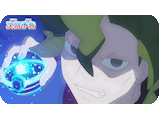
"Satoshi Tajiri World"
Long Interview Excerpt



Main
Old Updates Archive
Links
 |
Lists |
List of Pokémon
Pokémon World Atlas
List of Techniques
List
of Items
List of TV Episodes
 |
Guides |
Episode
Comparisons
Movies
& Specials Guide
CD Guide
DVD Guide
Voice
Actors Guide
Lyrics Archive
Manga Guide
Video Games
 |
Miscellaneous |
Humor
Pokémon Bashing
Features
Rants
Dogasu's
Backpack
| Features | Pokémon Shock


The book Pokémon Story (ポケモンストーリー),
published in Japan in December 2000, ends with a 33-page interview with
Satoshi Tajiri conducted on May 2nd, 2000 entitled "Satoshi
Tajiri World" ~ Long Interview (田
尻智ワールド~ロングインタビュー). Like the rest of the book itself, the
interview starts
with Satoshi Tajiri talking about how he got started creating the video
game fanzine "Game Freak" before going into
the details of Pocket
Monsters Red & Green's development, the franchise becoming a
national sensation, and Pokémon's break into the international
markets. The interview is broken into eight parts.
Part 5 of the interview, "The TV Incident" (テレビ事故), provides us with roughly three pages of Mr. Tajiri's (somewhat scattered) thoughts on the Pokémon Shock incident. And so I've translated those three pages for you below. To my knowledge this is the only interview in which Satoshi Tajiri talks about what happened the night of December 16th, 1997 and so you're in for a treat:
The following is a translation of pages 505 - 507 of the book Pokémon Story:
Part 5 of the interview, "The TV Incident" (テレビ事故), provides us with roughly three pages of Mr. Tajiri's (somewhat scattered) thoughts on the Pokémon Shock incident. And so I've translated those three pages for you below. To my knowledge this is the only interview in which Satoshi Tajiri talks about what happened the night of December 16th, 1997 and so you're in for a treat:
| The TV Incident |
The following is a translation of pages 505 - 507 of the book Pokémon Story:
| The TV Incident So the TV incident with the animated series... Um, I guess I first heard about it on the radio from NHK news. It was still pretty early, maybe around 7 o'clock or so? I was on the car ride home when I heard about it and so I turned around and went straight back to the office. But when I got back none of the people there had any clue anything was even going on. We've been living with TVs ever since we were little, and that's especially true with today's generation of kids, and I think maybe that right there is the danger with the medium. Back in my day, our parents used to yell at us if they saw us sitting too close to the TV. But now? You don't really hear about that much anymore, even though TVs have gotten way bigger since then. While I think this incident in particular was truly an unfortunate accident, it's not like the dangers inherit with TV hadn't always been there. It's just that we adults had been too careless to realize that the medium's effect on children was even greater than what we had imagined. I thought this back then, and to be honest I don't think much has really changed in all the years since. Well, my thoughts on them not changing haven't changed, is what I'm trying to say. Nobody ever took the time to stop and think about whether or not TV was actually safe for us to watch. Instead, all anyone could think about was how to make the shows more exciting and more shocking, thus making them more money. After the incident, a certain network put out a message "to all the good boys and girls" telling them to sit as far away from the TV as possible. I found this approach to be a bit too cavalier, too insincere. And addressing that message to "all the good boys and girls" just feels like they're trying to shift the blame to the viewers, you know? But then what can you expect when your industry puts out all these rules and regulations but then relies on technology to do the bare minimum required to be compliant? In the end, I think the way we watched TV was definitely a major factor here. I don't think there's been enough research into how TV screens have gotten bigger and bigger while, at the same time, more and more children are being left home alone to watch it by themselves. Or, research into the effects these shows have on the kids getting sucked into them. This lack of research was a problem then and it's a problem now. The Pocket Monsters animated series also airs at a time when mothers may or may not have gotten home from work, when children's stomachs are starting to grumble because they haven't had dinner yet. And while every child watches different things, of course, generally speaking the quality of TV has gone down so much that when kids do happen to find something on TV they like, they tend to scooch up close, trying to get a better look. They then get so caught up in these shows that they keep subconsciously inching closer and closer to the TV screen. But nobody seems to have an answer on how to deal with that problem, do they? When I heard the news on NHK I went back to the office since I knew there'd still be people there working. I thought I'd go there, tell them what I heard, and then we'd all put our heads together. I figured it'd be better to be in the office while we worked to gather information. I also imagined the people on the animation side would've been running around their offices like chickens with their heads cut off, wondering how in the world those types of scenes made it into their show in the first place. Of course, there didn't end up being any one single root cause, or any one way the public was affected by this. The incident was a combination of many contributing factors, all happening at the same time. But even back then, we all knew the environment in which kids watched Pokémon and the way Japanese kids and adults were interacting with TVs played more of a role in this incident than the actual flashing scenes themselves. And so, TV shows recklessly started pushing the limits again, slowly ramping up the number of flashing scenes in their shows. You could say they were living on the edge....? But those other shows don't quite have the je ne se quoi that Pokémon has; they think just making your show all bright and flashy will be enough to get people to line up to watch it. So thank you, guys, for continuing to provide us with an endless number of opportunities to allow this kind of thing to happen again. I will say, however, I have some objections with the way some people treated this whole situation as if it's some kind of unspeakable taboo. We should be having a thorough investigation and dissection of what exactly happened, and then hear the report on that. But of course, the TV network just wanted to hurry up and put this whole messy business behind them. If they could have gotten away without even addressing it then they probably would have, you know? And so what ends up happening is we're left wondering why this really happened, and what we would do if it were to ever happen again. If we could all just keep the conversation going instead of rushing to close this case with a bunch of questions left unanswered, then I think that all media -- animated series, video games, and TV shows -- from here on out can become much better. |
| About
the Book |
|
 |
Pokémon Story ポケモンストーリー Written by: Kenji Hatakeyama and Masakazu Kubo Published by: Nikkei BP-sha (日経BP社) Language: Japanese Page Count: 543 First Printing: December 10th, 2000 MSRP: 1,400 yen (not including tax) ISBN-10: 4822241998 ISBN-13: 978-4822241995 Available from
| Amazon Japan | Amazon US | | Amazon Canada | Amazon UK | | National Library of Australia | | Yodobashi.com | |
| Blurb |
|
| How was Pocket Monsters brought into this world? How was it able to evolve from the games into the world of comics, animation, and the movies? And why was it able to succeed in capturing the hearts of children all over the world? In this, the first business story book of its kind, one of the producers himself tells us by talking directly to the people who were there! Also includes an original interview with the creator of Pokémon himself, Mr. Satoshi Tajiri. | |
Found an error or omission? Please help me keep this page current and error-free by e-mailing me with a description of the issue.

